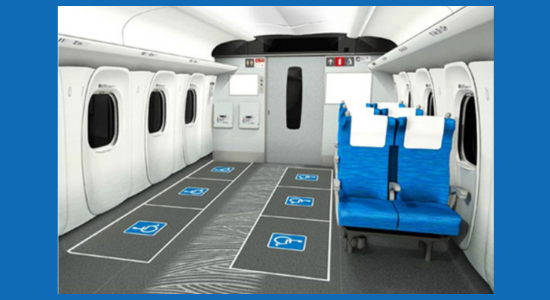Traveling by Shinkansen, Japan’s famous bullet train, is a comfortable and convenient way to explore the country. If you use a wheelchair, you might be wondering how accessible the Shinkansen is and what you need to know to make your journey smooth and stress-free. This guide will walk you through the steps to ensure a pleasant and accessible ride on the Shinkansen.
Accessibility of the Shinkansen
Japan’s Shinkansen is known for its high speed, efficiency, and accessibility. Almost all Shinkansen trains are wheelchair-friendly, with dedicated spaces for wheelchair users and accessible bathrooms in many cars. Here are some key points to keep in mind:
Elevators and Station Navigation
Most major Shinkansen stations are fully accessible with elevators and ramps, making it easy to get from the entrance to the platform.
Elevators:
Every major Shinkansen station (such as Tokyo, Kyoto, Osaka, and Hakata) has elevators connecting the main floors to the platforms. The elevators are typically wide enough for wheelchairs and can accommodate multiple people.

Wheelchair-Accessible Waiting Rooms:
Many Shinkansen stations have waiting rooms or designated areas for people with disabilities, providing a comfortable space while you wait for your train.
Platform Markings:
There are clear signs and markings on the platform to indicate where to wait for specific carriages, including those with accessible seating.

Braille and Audible Information:
For visually impaired passengers, many stations include braille signage and audible announcements to assist with navigation.
Wheelchair-Friendly Seats
Most Shinkansen trains have reserved spaces for wheelchair users located near the entrance doors for easy access.
The multi-purpose room on the Shinkansen is a private, enclosed space available for use by passengers with disabilities, those feeling unwell, mothers who need to breastfeed, and passengers requiring extra privacy. The multi-purpose room is generally available to any passenger if it is not already occupied and the train staff determines that it is necessary. However, only passengers who hold a disability certificate or equivalent documentation, as determined by each railway company, are eligible to reserve the room in advance.
Accessible Bathrooms
Many Shinkansen trains have large, wheelchair-accessible bathrooms with automatic doors and handrails.

How to Reserve a Wheelchair Space
It is essential to reserve a wheelchair space in advance, as there are limited spots available. Here’s how to make your reservation:
Booking at the Station:
You can book wheelchair-accessible seats at any JR station’s ticket office (called Midori no Madoguchi) or through a travel agency. Be sure to mention that you are traveling with a wheelchair so they can assign you to a dedicated space.
Telephone Reservations:
You can also reserve wheelchair-accessible seats by phone. JR has dedicated phone lines for inquiries, and they can help you check availability and book the seat you need.
Online Reservations:
Reservations can be made through websites like JR East’s “Eki-net” or “Smart EX”.
If you’re unable to book a wheelchair-accessible seat before your trip, you can make the reservation at a JR ticket office once you arrive in Japan. However, availability might be limited, especially during busy seasons, so booking early is always recommended.
Boarding the Shinkansen
When it’s time to board, the train staff will assist you to ensure everything goes smoothly.
Arrival at the Station:
Arrive at the station at least 30 minutes early. You can ask the station staff for help at the ticket gates, and they will guide you to the train platform.
Platform and Boarding Assistance:
Station staff will use ramps to help you board the train safely, as there can be a gap between the platform and the train.
Dedicated Spaces:
Once onboard, you will be directed to the reserved wheelchair space, where your seat and area are more spacious to accommodate the wheelchair.
Travel Tips for Wheelchair Users
JR Pass Considerations:
If you are using a JR Pass, you can also reserve wheelchair-accessible seats with it. Be sure to mention your wheelchair when reserving.
Shinkansen Types:
Not all Shinkansen types are equally accessible. The newer N700 series tends to have better accessibility features, so ask for these trains when booking.
Baggage Space:
If you are traveling with additional baggage, there is extra space near the wheelchair seating area for storage.
Conclusion
Riding the Shinkansen in Japan as a wheelchair user is both convenient and easy with a bit of planning. By booking your seat in advance, arriving at the station early, and asking for assistance from the friendly staff, you can have a comfortable and enjoyable journey across Japan. Ready to explore? Make your reservation today and experience the wonders of Japan’s Shinkansen.
Klook.com



